
"Any reader who has come with me so far through the Iberian Peninsula should be prepared for a pilgrimage across northern Spain to the sanctuary at Santiago de Compostela, the finest journey in Spain and one of the two or three best in the world. It is a twofold pilgrimage to a long-dead form of art and to a living religious shrine."
James Michener, Iberia
Last June, my father and I cycled 803 kilometers across Northwestern Spain along the Camino de Santiago from Madrid to Finisterre.
Several months ago, I documented the first phase of the journey from Madrid to Sahgün, the much less known 320 km route that runs north over the Guadarrama Mountains and over the Spanish plains and mesas of Castilla. This entry tells the remaining story of our journey from Sahagún, the confluence between the ruta Madrd into the most popular and traditional route of the pilgrimage, el Camino Francés, to Santiago de Compostella and Cabo Finistere.

Part II of Camino de Santiago Installment, Sahagún to Santiago to Finisterre

Refresher: The Way to Santiago
The Camino to Santiago de Compostella is one of the most famous and ancient pilgrimages in western civilization. Going along various routes of the historic Camino de Santiago, we cycled mostly off road, and the trails varied from wide dirt paths, to winding single track, to steep technical climbs and descents, to ancient Roman roads. They were at times isolated and at many points we shared the trail with hundreds of fellow pilgrims making the trek on foot, bicycle, horse, and donkey. They started from all points in Europe, and had come from every corner of the earth. I hope to capture the beauty, diversity, and hospitality of the Spanish Landscape and Culture. These posts are dedicated to my brother Adam, who unfortunately was not able to join us on the Camino, his absence was missed.
Phase 2: Out of Isolation and onto the Pilgrim Highway 
This leg of the trip featured two particularly strenuous mountain ascents.
"Hey Pop, I don't think we're on the Camino Madrid anymore"
This became quite obvious as soon as we hit the confluence with the Camino Frances in Sahagún; we rode into a current that was loaded with countless fellow pilgrims. Within the first half hour of hitting the most popular route, we saw more pilgrims than we had in the last 5 days since Madrid.
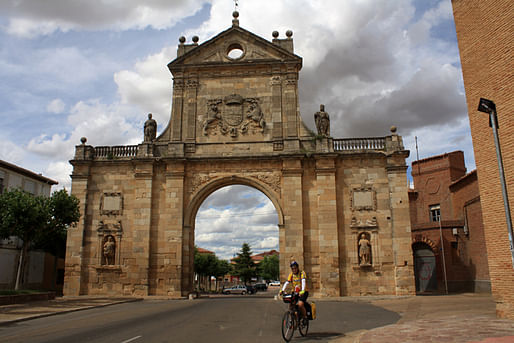
Triumphal arch of Sahagún, note the lions around the coat of arms, we are now in the fiercely regionalist León territory. 
Sahagún was once home to one of the most influential Cluny Monasteries in the world, strategically built at this mid point of the Camino for pilgrims making the journey. It unfortunately burnt to the ground in the 19th Century
Fascinating layers in the broken vault 
The first leg out of Sahagún was rather a disappointment. In addition to flat, terrible headwind along a non-scenic highway, we had to deal with the immense amount of pilgrim traffic, which was a bit of a shock for us after coming off of the much more solitary way from Madrid... things however, got much better once we hit the city of Leon. Here, we get a glimpse of the mountains to come...
Doesn't matter where, there is always a Cigüeña nest on the belfries of Spain.
Leon
Quick sketch of León's famous Cathedral... an early Gothic structure that is beautifully asymmetrical in its façade, and exemplifies the best kind of Gothic in my opinion; clean and simple, in which almost al interior details are directly tied to the structure - all in the name of verticality. 

Lions of León
More Nests
Accommodations along the Ruta Frances are more diverse: here we have the famous 5 star "Hostal San Marcos" in Leon, this 16th-Century Renaissance beauty was built as a monastery and later converted into a parador for wealthier pilgrims making the arduous journey... it remains so today, and one can still get a room for only 125 Euros a night.
Although we were technically in the region of Castilla y León, we saw much evidence of the famous Spanish Regionalism. Here, graffiti from Leones separatists calling for autonomy from its current state of 'Castilla y León,' for they simply want to be León. Indeed, as we passed through both portions of Castilla y León we noticed distinct differences in the people, culture, landscape, and architecture. South of León people referred to their territory as "Castilla" and in Leon only "León." The graffiti reads "León Country."
The famous bridge of Rio Órbigo where the knight Suero de Quiñones stood for 30 days to fight every knight crossing as a way to prove that he was the strongest and bravest knight on the way of Saint James. Orders of knights were formed and sent to the Camino in medieval times to protect pilgrims, including the Order of Santiago, and the Knights Templar. One of the most famous hospitals of the medieval pilgrimage lie here as well. Hospitals were first conceived along the camino, as places to take in and help nurse sick and wary pilgrims back to health, thus deriving from "hospitality." 
City hall in the City of Astorga - it had an amazing mechanized belltower.
One of Antonio Gaudí's earlier works... built as a palace for the local Bishop, this project was a bit of a scandal. The Bishop, being Catalán, chose Gaudí to design the palace from Barcelona. Going many times over the budget the bishop was forced to resign in shame. 
You can clearly see the beginnings of quintessential Gaudí playfulness. 
Cathedral of Astorga
After Astorga was a slow, sluggish, winding climb up into cold mountain hills that afforded beautiful views of the country-side. 
My father and me atop the Cruz de Ferro (Iron Cross), that is set atop a pile of stones. Tradition has it that the pilgrims would carry a stone from their homeland and would place it here as an offering, having climbed to the high point of the mountains. 
The next twenty kilometers gave us fantastic weaving descents both on and off-road. 
Although still in León, on the other side of these mountains we could sense an immediate change of character in the build environment. Entire towns like El Acebo, above made out of stone and granite... the first hints of what was to come in Galicia. 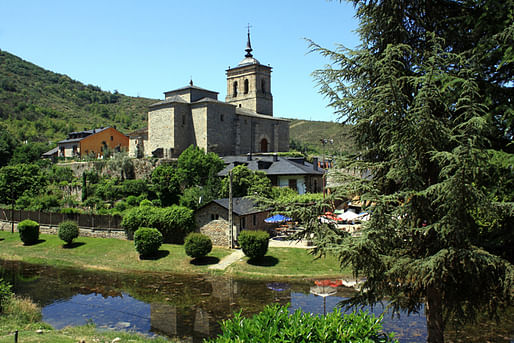
Beautiful mountain town of Molinaseca (Dry Windmill), verdant, rocky, and full off varied topography. We could have stayed here for days, but the camino beckoned. 
Shortly after we arrived in the city of Ponferrada. It is home to a wonderfully preserved castle that used to be the fortress of the division of Knights Templar assigned to protect pilgrims from thievery along the way. The violent character of the towers was unlike any of the many castles we encountered on the trip. Wonderful stop. 
"Ecohome" on display inside the castle walls. 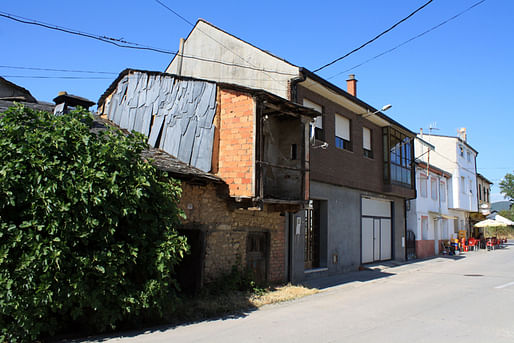
In the sleepy village of Fuentes Nuevas, we passed these very curious dwellings that were crumbling into a ruinous state. At a squint, the jetty of the large open porch makes makes the house look like something out of Dwell magazine, if one were to wrap it in new materials. 
Built of stone and time. Stone walls and stone roof. 
Cycling through the vineyards of the high quality and underrated Bierzo region
We spent the night in the mountain town of Villafranca to rest up before the largest climb of the journey. The city has become so large because of this very reason, for the climb after here was historically the most dangerous for way finding pilgrims. Pictured above is the pass Leaving Villafranca... Another stone bridge that I fail to give justice to its beauty and grace as a human-built object. 
Just as impressive as the stone bridge were some of the modern feats of engineering we saw... highways spanning entire mountain valleys... note the cars and trucks for scale. 
The climb kept going and going...
The ever-changing views of the landscape kept our spirits high. 
After the grueling 2,400 foot climb, we cross into the magical land of Galicia, at the ancient stone town of El Cebreiro, formed as a place to help shelter pilgrims who survived the climb. 
Our first encounter with the celtic lands of Galicia. 
Dry laid granite and thatched roofs.
Impeccable mason work.
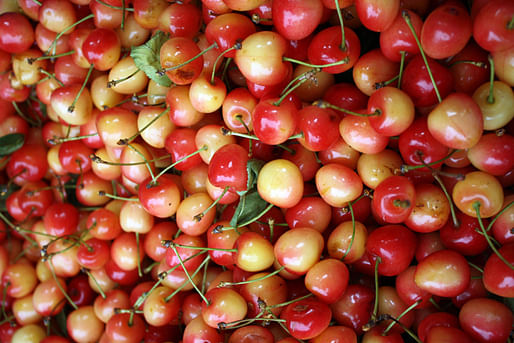
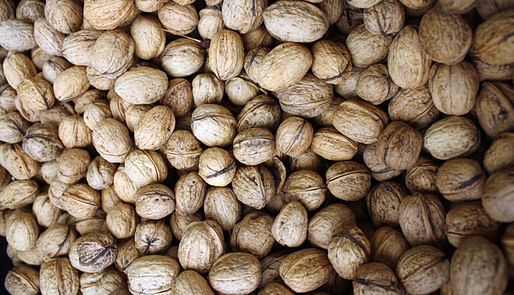
Yum. The cherries of Galicia were the highest quality I have ever sampled. I cannot put into words how good these tasted after our half day climb.
Slate roofs
Slate walls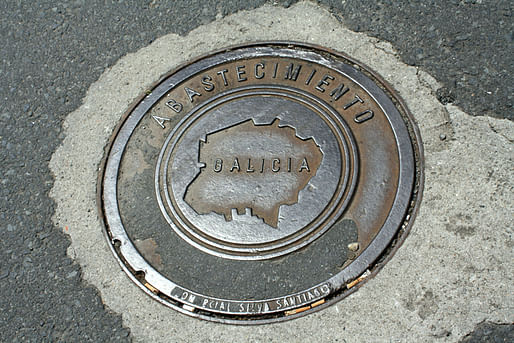
Galicia is like no place in Spain.
It rains quite often in Galicia, and we were incredibly lucky. We only experienced a few hours of rain. At the time of this photo, it had just finished a light drizzle, and would be the last rain we'd see for the trip. This is the monastery of Samos, another magnificent structure built in the name of the pilgrimage. 

 Remnants of the León kingdom in the city of Sarria. From this point on the traffic on the camino was the heaviest. As Sarria is at the 100km mark to Santiago, the minimum distance one must walk to receive an official "compostela" of the pilgrimage.
Remnants of the León kingdom in the city of Sarria. From this point on the traffic on the camino was the heaviest. As Sarria is at the 100km mark to Santiago, the minimum distance one must walk to receive an official "compostela" of the pilgrimage.
However, this last leg of the journey was easily one of the most scenic, joyful ones to travel, despite the heavy traffic. 
Every small stone town was accompanied by these stone cemeteries.
Death on the Camino.
Elevated grain stores

A mix of tight wooded trails...
And expansive lush vistas that seemed too perfect to be real. I did not feel like I was in Spain.
Entry gate to the city of Portomarín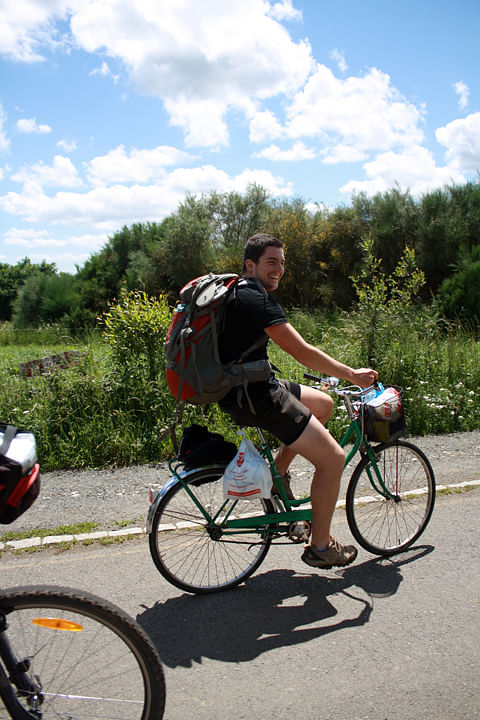
We ran into this lovable Porteño, Liam, from Argentina who had ridden this piece of junk all the way from Pamplona... 80 pound bike, no gears, no brakes, no helmet, a backpack and plastic bags off the ends. 18 years old, strong as an ox, completely reckless, but an absolute joy to ride with and meet this winsome smiling kid. He rode with us for about 20 km before stopping at a hostel to wait for a friend. We ended up bumping into him again in Santiago, unfortunately to hear that he had crashed his bike, bent the wheel, and had to walk the last few kilometers carrying the bike on his back. The characters we met along the way added to the specialness of the pilgrimage.
Juventud, divino tesoro, ya se va, para no volver.

An old white plaster romanesque church, recalling memories of early Scandinavian modernism.
Perfectly imperfect stone window.
Fields
Bridges
Galicia.
At long last, we reach the Cathedral of Santiago!
James Michener has called the Praza do Obradoir ('plaza of the worker' in Gallego) the second finest in Spain, ranking only slightly behind the main plaza in Salamanca. "Four handsome buildings delineate it," he says, "each with its distinctive style, so that poets have said that at night one can hear a whispered colloquy among architectural styles that have made Spain beautiful: Romanesque at the religious college, plateresque at the Hostal de los Reyes Católicos, 18th-Century neoclassical in the city hall, and the wildly ornate baroque of the cathedral."
I agree with his assessment.

The cathedral of Santiago breathes with life....
The intense verticality, ornament, and motifs of the baroque facade are combined with a living layer of moss and grass that comes from the wet climate of Galicia
The growth on the cathedral gives the building an even more timeless character, lending one to believe it was simply carved out of an existing rock.

Every turn of the corner I encountered a new sensation. The building is one that deserves hours and hours of continuous observation, for the details are innumerable.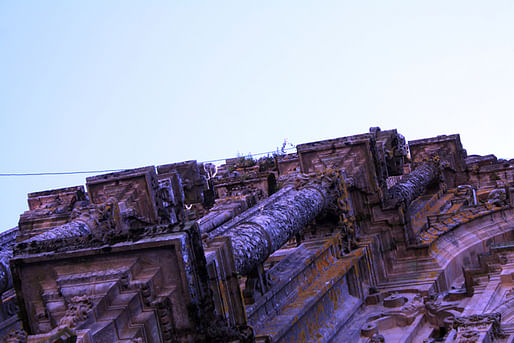


 The roof is made of THICK slabs of stone to shield it from catapult attack and fire in medieval times.
The roof is made of THICK slabs of stone to shield it from catapult attack and fire in medieval times.

Indeed, the stonework is outstanding.
Looking down at the Praza da Quintana, on the east end of the cathedral.

North end of the Cathedral
The medieval streets of Santiago
Shaded passage in the streets of Santiago
Peter Eisenman's City of Culture... rather disappointing: empty, void of life, and removed from the city, ironic, given the complex's name.
Phase 3: Journey to the End of the Earth
The last component of this magical trip was a one day, 90 km ride out to the western coast of Spain, Cape Finisterre. The name literally means "end of the earth," as this was thought to be the westernmost point of continental Europe (the actual westernmost point is in Portugal). It was a fantastic way to end the jouney.

Leaving Santiago with the cathedral at our back.
We stopped to picnic at this scenic medieval river bridge.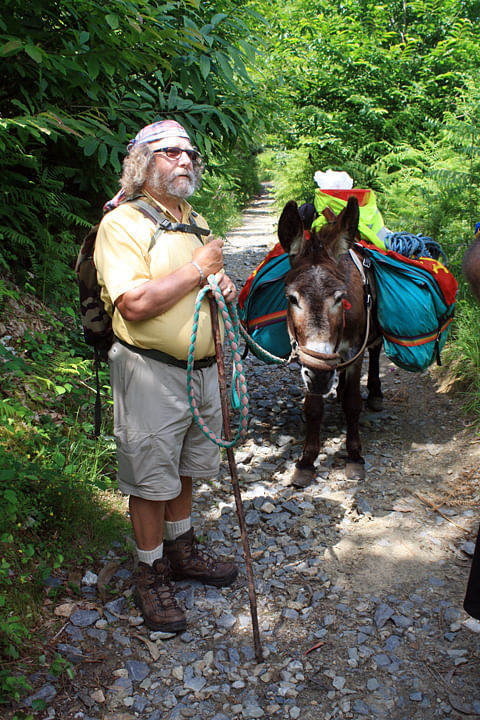
Still loaded with Pilgrims, we met this character from France who had walked all the way from his farm with his donkey. He was now on his way back home by foot. A handful of the pilgrims choose to do this, as this is what a true pilgrimage was then: an out and back journey. There was no airport or train to take you home back then. 
A contemporary albergue.
Rocks, hills, and windmills.
Our first glimpse of the Atlantic Ocean. Hard to believe we began in Madrid. 
A joyous moment.
A happy but rough descent to the sea.

Barrel-shaped, traps 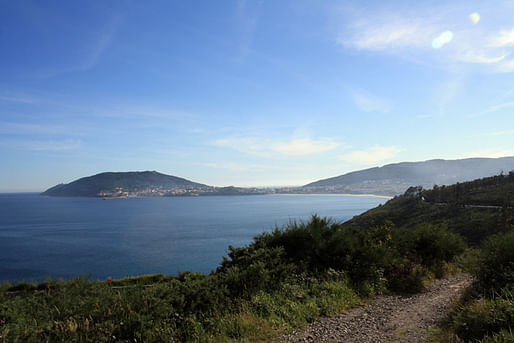
Our first view of Finistere, it includes a long, beautiful, and sheltered beach. 
Kids going fishing
The seafood throughout Galicia, particularly the squid and octopus, was first rate.
Eco hotel tucked into the hillside.
The lighthouse of Cabo Finistere
Like a more dramatic Maine coast. 
Sitting at the end of the world
Lizard.
Fin del mundo
Happy pilgrims at the zero kilometer marker. We started at 803. An experience of a lifetime. I sincerely hope to do it again. Maybe by foot. Thanks for reading!

This work by A.D.Morley is licensed under a Creative Commons Attribution-NonCommercial-NoDerivs 3.0 Unported License.
A new adventure begins as we finish one chapter; we hope to share our story with you. We are graduates of Washington University in St. Louis, Sam Fox School of Design & Visual Arts.
4 Comments
great post! love all the photos and sketches, looks like you had a great time. too bad the eisenman thing was a let down .. any other photos of that thing?
Thanks for sharing this! It's amazing to see the juxtaposition of how naturally Santiago de Compostela fits in with Galicia as compared to the void of life created by Eisenmann. Your sketches do a great job rendering the vivid nature of Baroque ornamentation.
sketches are fresh and vibrant... I just love them all
represent!
Block this user
Are you sure you want to block this user and hide all related comments throughout the site?
Archinect
This is your first comment on Archinect. Your comment will be visible once approved.